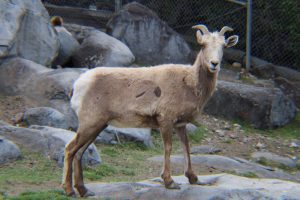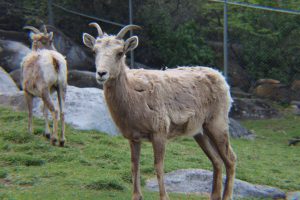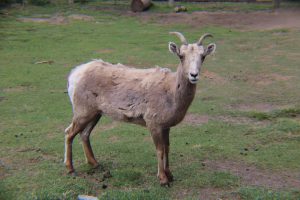Bighorn Sheep (Ovis canadensis)
Taxonomy
Kingdom: Animalia
Phylum: Chordata
Class: Mammalia
Order: Artiodactyla
Family: Bovidae
Sub-family: Caprinae
Genus: Ovis
Species: Ovis canadensis
Conservation Status in Idaho
Imperiled because of rarity or because other factors demonstrably make it very vulnerable to extinction.
Range and Habitat
Bighorn sheep are found in the Rocky Mountains from southern Canada to Montana and Idaho south through Wyoming and northern Utah, Colorado and New Mexico. A desert subspecies is found in Nevada and California to west Texas and parts of Mexico. Bighorn sheep occupy alpine meadows, grassy mountain slopes, and foothill country that are close to rocky cliffs and bluffs. They require drier slopes with less annual snowfall due to their inability to paw through deep snow to feed.
Physical Features
Weight: Males, 262–280 lbs (119–127 kg); Females, 117–200 lbs (53–91 kg)
Length: Males, 5.25–6.0 ft (1.6–1.8 m); Females, 5.0 ft (1.5 m)
Shoulder height: Males, 3.0–3.5 ft (0.9–1.0 m); Females, 3.0 ft (0.9 m)
Horns: Males, greater than 30 in (0.76 m) in length, 15 in (0.4 m) in circumference, and can weigh over 30 lbs (14 kg); Females have significantly smaller and less curved horns
Bighorn sheep have compact muscular bodies with chocolate brown fur with white on the muzzle, rump and belly. Rams have large curved horns while ewes have much smaller horns with a slight curve. Bighorn sheep outer hooves are modified toenails shaped to snag slight protrusions and a soft inner pad that provides grip as they are climbing steep terrain.
Diet
Bighorn sheep are grazers that primarily eat grasses, clover, and sedges. During colder months bighorn will transition to more woody plants.
Lifespan
Bighorn sheep live between 15-20 years in the wild and captivity.
Reproduction
Breeding season (rutting) begins in the fall to early winter. Males (ram) do not defend a territory but fight for access to females. Rams participate in head-to-head combat by smashing into components at speeds of 20 miles per hour with their horns. Combat between two rams can last for 24 hours. Dominance is dependent on age and horn size and as a result males tend not to breed until age seven. Females (ewes) are polyestrous and will accept multiple rams during rut. In the wild ewes tend not to breed until age two or three. In captivity they have bred as early as one year. Gestation lasts from 150-180 days with one, rarely two, lamb(s) born. Lambs are precocial and able to follow their mother over rocky terrain around one week after birth. Lambs are weened by four to six months.
Social Behavior and Interaction
Bighorn sheep are gregarious typically forming groups of eight to ten and at times form herds of over 100 individuals. Females form family groups led by an older ewe while mature rams form bachelor groups. Young males typically leave the family group between two and four years to join the bachelor groups. Bighorn sheep undergo seasonal movements using upland areas in the summer and sheltered valleys in the winter. Bighorn sheep are good climbers using ledges as small as two inches wide. They can run on level ground as fast as 30 miles per hour and scramble up slopes at 15 miles per hour.
Major Threats
Epizootic (localized breakouts) disease such as mange and pneumonia, poaching, habitat degradation, and completion from domestic livestock.



